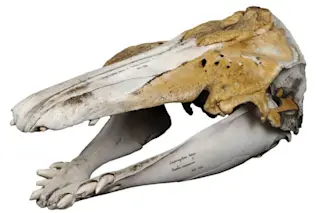While visiting West Greenland in the 1980s, an Inuit hunter killed an odd-looking whale. He realized there was something unique about the animal, so he kept its skull. Years later in 1990, a researcher from the Greenland Institute of Natural Resources spotted the specimen mounted on the hunter’s toolshed.
In its top jaw, the skull featured what looked to be a narwhal tusk, though nowhere near as long. The bottom jaw, though, looked distinctly un-narwhal-like; it had teeth, to begin with, and they stuck out at odd angles. The hunter reported he had caught the whale during a subsistence hunt. Two similar-looking whales had been nearby and he had killed these animals as well. All three whales had evenly gray skin and pectoral flippers akin to belugas’. But their tails looked like narwhal tails.
Now University of Copenhagen researchers find the skull belonged to an unprecedented hybrid animal — a ...














